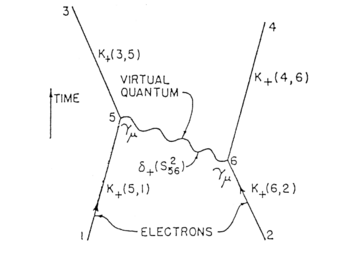Richard Phillips Feynman: Difference between revisions
Cjohnson354 (talk | contribs) No edit summary |
Cjohnson354 (talk | contribs) |
||
| Line 34: | Line 34: | ||
===External links=== | ===External links=== | ||
http://www.findagrave.com/cgi-bin/fg.cgi?page=gr&GRid=2562 | |||
http://blog.nuclearsecrecy.com/2014/06/06/feynman-and-the-bomb/ | |||
==References== | ==References== | ||
Revision as of 10:28, 30 November 2015
Claimed by Catherine Johnson
Richard Phillips Feynman, an American theoretical physicist, was quite famous for his work with quantum mechanics, electrodynamics, and superfluidity, but was most known for his familiarization with particle physics. He proposed the parton model in 1969.

Early Life
Feynman was born in New York City, New York, on May 11th, 1918, to Lucille and Melville Arthur Feynman. His parents originated from Poland and Russia, and both were Ashkenazi Jews, or "Germanic Jews". However, neither of his parents were very religious, and therefore, Richard proclaimed himself atheist as a young boy. Feynman could not talk until the age of three, but once he could, he closely retained his Bronx accent. As Feynman grew, his parents were greatly supportive of his creative mind-set. His father continuously pushed him to think beyond the box, and his mother provided him with a sense of humor that carried him happily through life. He became a little engineer all on his own, and by age 10, he created a home burglar alarm while his parents were out. At age nine, Feynman gained a baby sister Joan, and the two became very close. Although Richard's mother disapproved of Joan's high level of curiosity for a woman, Richard always encouraged his little sister, and she later became an astrophysicist specializing in Earth's solar winds. Due to his family's constant support, Feynman developed a general curiosity about the world that led him to discover great things in the future.
Education

Feynman was always very dedicated to his school work. While attending Far Rockaway High School as a teenager, he taught himself many disciplines of mathematics that usually only collegiate students could perceive. He graduated from Far Rockaway in June of 1935, and was accepted and soon attended the Massachusetts Institute of Technology (MIT). He graduated from MIT with a BS degree in Physics in 1939, after realizing his initial passion with mathematics did not carry far enough into the world of application, in his opinion. He then followed his studies with quantum mechanics to Princeton University, and received his doctorate in physics in 1942. Feynman joined the Manhattan Project during World War II and was the head of the theoretical division. He later was appointed a professor at Cornell University, but he soon transferred to the California Institute of Technology in 1950 to develop his interest in quantum mechanics.
The Manhattan Project
Connectedness
- How is this topic connected to something that you are interested in?
- How is it connected to your major?
- Is there an interesting industrial application?
See also
Are there related topics or categories in this wiki resource for the curious reader to explore? How does this topic fit into that context?
Further reading
Books, Articles or other print media on this topic
External links
http://www.findagrave.com/cgi-bin/fg.cgi?page=gr&GRid=2562 http://blog.nuclearsecrecy.com/2014/06/06/feynman-and-the-bomb/
References
https://www.grc.nasa.gov/www/k-12/airplane/thermo0.html http://hyperphysics.phy-astr.gsu.edu/hbase/thermo/thereq.html https://www.grc.nasa.gov/www/k-12/airplane/thermo2.html http://www.phys.nthu.edu.tw/~thschang/notes/GP21.pdf http://www.eoearth.org/view/article/153532/